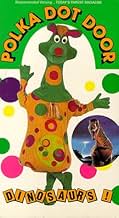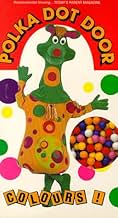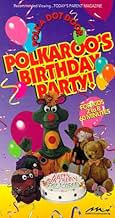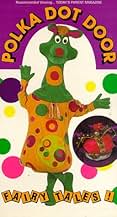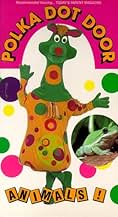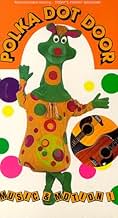Programa infantil protagonizado por dos presentadores humanos y el Polkaroo, un canguro travieso.Programa infantil protagonizado por dos presentadores humanos y el Polkaroo, un canguro travieso.Programa infantil protagonizado por dos presentadores humanos y el Polkaroo, un canguro travieso.
Explorar episodios
Opinión destacada
It appears that "Polka Dot Door" started out fifteen years before I was born, but ran for over twenty years in total. I first saw it at a very early age, and think I saw reruns of it shortly after its demise (even though I may not have liked it as much by then, as I may have been slightly past the age group it was meant for). It may not have been one of my childhood favourites, but I still found it entertaining for a while, enough for me watch many episodes, leaving me with permanent memories.
The show featured two hosts, one male and one female. The hosts of the show would change from time to time. It took place inside a large playhouse, which the hosts would enter through the Polka Dot Door. The two hosts of the episode would provide the young viewers with "songs, stories, and so much more." A group of stuffed toys, Marigold, Humpty, Dumpty, and Bear, lived in this playhouse. After the hosts came in, they would take these stuffed toys out of the box and do various activities with them. Towards the end of the episode, the Polkaroo (a mischievous kangaroo in polka dots who never said anything other than "Polkaroo!") appeared just outside the playhouse.
Some parts of that description may sound a bit silly, but remember, this was a programme for the very young folk, and despite how incredibly simple it was, it pleased many of those in the age group it was meant for in Canada, as well as some in the United States! It could also be educational for them in some ways. Since the show ran for over twenty years, it was obviously very successful, and people from several generations can say they watched it during an early part of their childhood! For all those reasons, "Polka Dot Door" definitely deserves some credit.
The show featured two hosts, one male and one female. The hosts of the show would change from time to time. It took place inside a large playhouse, which the hosts would enter through the Polka Dot Door. The two hosts of the episode would provide the young viewers with "songs, stories, and so much more." A group of stuffed toys, Marigold, Humpty, Dumpty, and Bear, lived in this playhouse. After the hosts came in, they would take these stuffed toys out of the box and do various activities with them. Towards the end of the episode, the Polkaroo (a mischievous kangaroo in polka dots who never said anything other than "Polkaroo!") appeared just outside the playhouse.
Some parts of that description may sound a bit silly, but remember, this was a programme for the very young folk, and despite how incredibly simple it was, it pleased many of those in the age group it was meant for in Canada, as well as some in the United States! It could also be educational for them in some ways. Since the show ran for over twenty years, it was obviously very successful, and people from several generations can say they watched it during an early part of their childhood! For all those reasons, "Polka Dot Door" definitely deserves some credit.
- Beta_Gallinger
- 10 ago 2007
- Enlace permanente
Argumento
¿Sabías que…?
- TriviaThe Polka Dot Door aired every weekday. Each day of the week had a different consistent theme. Monday was "Treasure Day". Tuesday was "Dress-Up Day". Wednesday was "Animal Day". Thursday was "Imagination Day". And Friday was "Finding-Out Day".
- ConexionesFeatured in Toronto Stories (2008)
Selecciones populares
Inicia sesión para calificar y agrega a la lista de videos para obtener recomendaciones personalizadas
- How many seasons does Polka Dot Door have?Con tecnología de Alexa
Detalles
- Tiempo de ejecución30 minutos
- Color
Contribuir a esta página
Sugiere una edición o agrega el contenido que falta

Principales brechas de datos
By what name was Polka Dot Door (1971) officially released in India in English?
Responda











